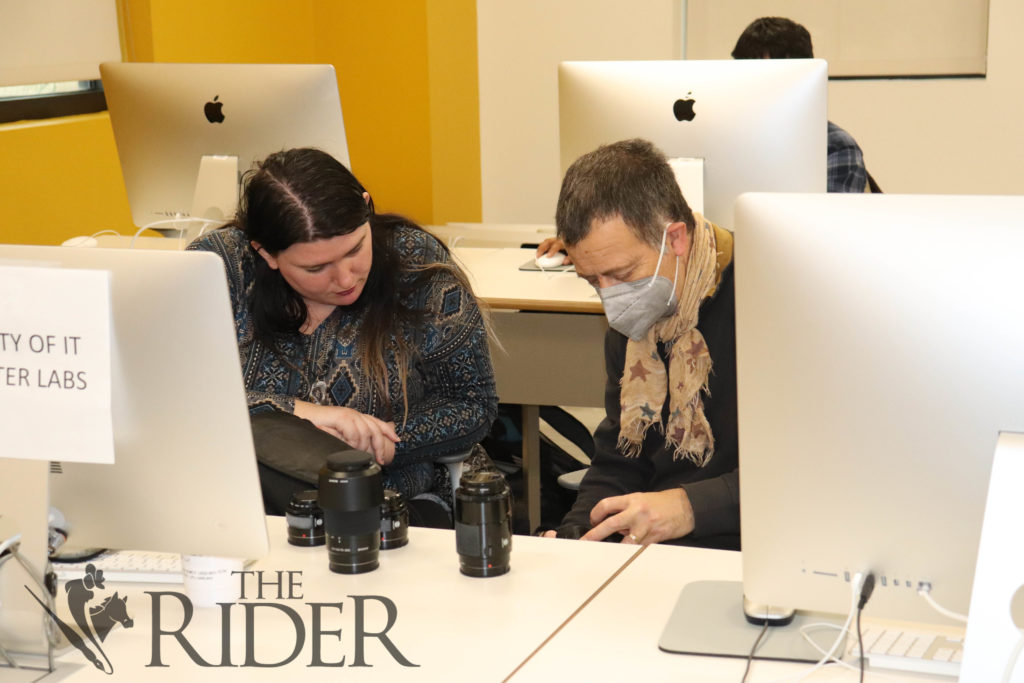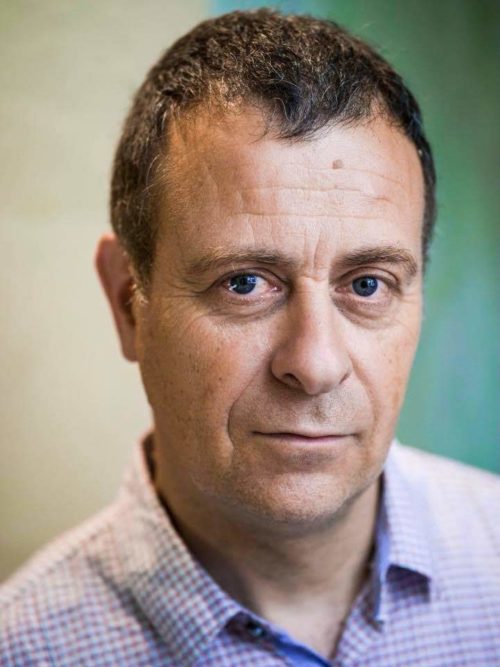
New Assistant Professor Romeo Di Loreto teaches Elizabeth Villarreal, a graphic design sophomore, how to change the settings on her camera during class last Thursday in the Music, Science, and Learning Center on the Brownsville campus. Citlalli Torres/The Rider
CLARIFICATION: To clarify, UTRGV does not throw chemicals down the drain. The university’s Environmental Health, Safety & Risk Management department properly disposes of chemicals used in the art building via a system of chemical waste, Di Loreto said in an email after publication of the article.
A new faculty member who has worked in different universities across the world hopes to make a great impact in the UTRGV School of Art and Design.
Romeo Di Loreto, a new tenure-track assistant professor, was born in Toronto, Canada. He first learned about UTRGV through a job posting.
“I made this courageous maneuver,” Di Loreto said. “I noticed the posting of the school and for others. I applied to three of them … a school in South Carolina [and] another one in Utah. Oddly enough, I don’t know how I did it, [but] I was given offers.”
He said there is something special about Brownsville–its weather and abundance of nature.
“You have the sea, you have the desert, you have the mountains [in Texas],” Di Loreto said. “And by studying this and researching, I realized it was very interesting for my work. It was actually fundamental for my work because a lot of my work is dealing with a natural element. Then, I started studying the school itself and the territory and the idea of it being a public research university really gave me a huge stimuli to think about it very seriously.”
Students have creativity and knowledge ready to explode like a volcano, the art professor said.

Di Loreto earned a bachelor’s degree in applied arts from Ryerson University in Toronto, Ontario, and a master’s in fine arts from Savannah College of Art and Design, a private nonprofit art school in Savannah, Georgia.
Although he earned two degrees, he did not always know what he wanted to do.
“I was offered a kind of training through a five-year military university, which really shocked me to be a criminologist for the Royal [Canadian] Mounted Police,” Di Loreto said. “They went through all these Scantron quizzes. So, this was kind of a blessing that I had a real job. Two weeks before I was able to go, I said, ‘I can’t do it.’ I did not go.”
He eventually found a one-year art program where he learned about painting, drawing, ceramics, industrial design, graphic design and photography.
“Photography was easy for me,” Di Loreto said. “The first time I picked that up was just easy, but I really had a passion for industrial design.”
The professor said some students may not always know what they want to do post-graduation, but he reassures them that it is OK.
“When I ask them what they want to do in life, they say, ‘I’m not sure,’ I say, ‘Great. I was not sure.’ I went through [a photography] program and, luckily, did extremely well in that.”
He added he is proud to be part of the UTRGV School of Art and Design and wants to see it grow. One of the ideas he has is to strengthen the graduate programs.
“What’s going to happen when they graduate?” Di Loreto said. “If they want to teach, they’re going to find themselves reading job applications and they’re going to say, ‘Three years experience,’ and they can have three spares. I also want to do some very unique things.”
He said he wants to implement the recycling of classroom materials to avoid throwing chemicals down the drain.
At one point, Di Loreto started his own business.
“I owned a [print] gallery and, actually, it was a custom laboratory where we did both color and black and white,” Di Loreto said. “My biggest clients were Vogue and Elle magazines. So, 20 years ago, anything you would have seen in Vogue and Elle black and white, and it was done by me. I was printing it.”
Famous photographers he worked for include Josh Sturgis, an American photographer; Joel Meyerowitz, an American street, portrait and landscape photographer; Paolo Pellegrin, a photojournalist from Italy; Gerhard Richter, a German visual artist; and Nobuyoshi Araki, a Japanese photographer and contemporary artist.
“After a while, I decided that maybe I should think about changing a little bit, and I started teaching part time,” he said. “From part time, they immediately offered me a full-time position at one university. It was actually a foreign-abroad program where we catered to 57 American schools, the oldest foreign-abroad program in the arts in Italy.”
Di Loreto advises students to “chase the wind and never catch it.”
“Go for it,” he said. “Make all the mistakes you possibly can and don’t be afraid. If you’re afraid, it’s OK to explain, to talk, to resolve. You don’t want to catch the wind, you want to keep on chasing it. At one point you are so thrilled that you’re doing things that you never expected, because our minds are much stronger, much stronger than we could have imagined.”
Hannah Cavazos, a studio art senior, is taking Di Loreto’s photography as an art form course.
Cavazos said Di Loreto gives the class a lot of artistic freedom.
“He’s totally OK if we fail because it’s OK to fail,” she said. “It’s, like, very free-formed. He’s very open to suggestions. If he gives an assignment, like, he wants us to be like, ‘Oh, well, I think this would be better.’ We have a voice in his class.”
Cavazos encourages students to take a course with him, even if they do not know anything about photography.
“Like, the majority of my classes I didn’t know anything about it,” Cavazos said. “But he’s very open and he’ll teach you from the very beginning, like, one on one. He’s very patient.”
Joy Esquierdo, interim director for the School of Art and Design, said Di Loreto’s enthusiasm was captivating.
“He seemed really excited,” Esquierdo said. “He seemed very student centered. A lot of those responses centered around the needs of our students. I think the background that he brings in, the years of experience that he brings in, is pretty exciting as well.”
Assistant Professor DM Witman, a new faculty member on the Edinburg campus, and Di Loreto have already submitted a proposal to update the terminology and the software that is being used in those classes, according to Esquierdo.
“I believe together, they’re really coming up with great ideas of how to update the curriculum,” she said. “And then, they talk about wanting to eventually make it, you know, think about offering a BFA in photography in the future, right? … I would think that’s a five-year plan, but it’s exciting to see the motivation for that. And, so, both of them coming up with, you know, projects in the area, you know, how they can involve their local communities and their … assignments and things like that.
So, it’s really neat to see their creativity, not only in their own work, but also what they plan on doing with the students.”





